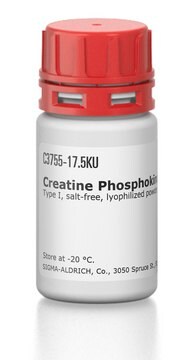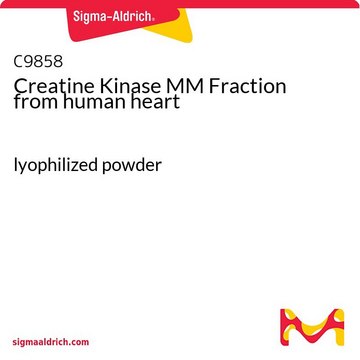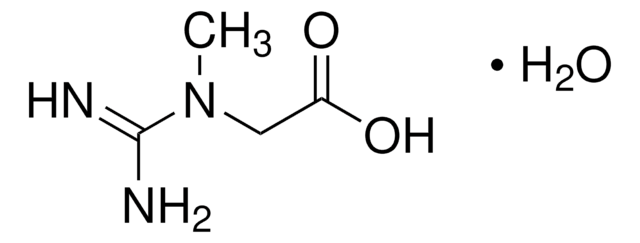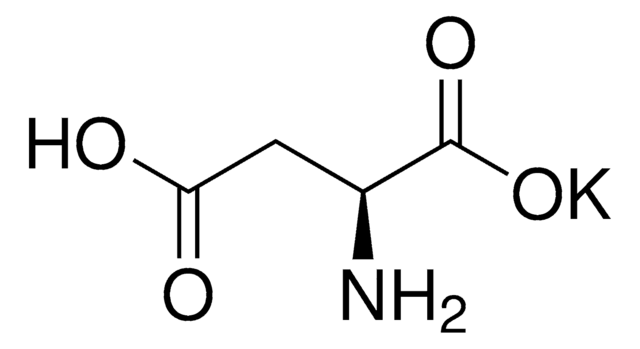C7886
Creatine Phosphokinase from bovine heart
Type III, salt-free, lyophilized powder, ≥30 units/mg protein
Synonym(s):
ATP: Creatine N-Phosphotransferase, CPK, Creatine Kinase, Phosphocreatine phosphokinase
Sign Into View Organizational & Contract Pricing
All Photos(2)
About This Item
Recommended Products
biological source
bovine heart
Quality Level
description
Contains primarily isozyme MM
type
Type III
form
salt-free, lyophilized powder
specific activity
≥30 units/mg protein
mol wt
80 kDa
storage temp.
−20°C
General description
Research area: Cell Signaling
Creatine phosphokinase (CPK) is an intracellular enzyme found predominantly in skeletal muscle, brain, and myocardium. CPK consists of two polypeptide subunits, namely M (muscle type) and B (brain type). The lighter subunit is present in larger amounts. The genes encoding these subunits are on distinct chromosomes, with B on 14q32 and M on 19q13. These subunits facilitate the development of three tissue-specific isoenzymes: CPK-MB (cardiac muscle), CPK-MM (skeletal muscle), and CPK-BB (brain).
Creatine phosphokinase (CPK) is an intracellular enzyme found predominantly in skeletal muscle, brain, and myocardium. CPK consists of two polypeptide subunits, namely M (muscle type) and B (brain type). The lighter subunit is present in larger amounts. The genes encoding these subunits are on distinct chromosomes, with B on 14q32 and M on 19q13. These subunits facilitate the development of three tissue-specific isoenzymes: CPK-MB (cardiac muscle), CPK-MM (skeletal muscle), and CPK-BB (brain).
Application
Creatine Phosphokinase from bovine heart has been used:
- in the reaction mix for the import of in vitro synthesized wild-type FLAG/MYC-tagged LYR Motif Containing 7 (LYRM7-F/M) or the LFK tripeptide replaced with alanine (LFK-AAA) mutant into isolated mitochondria
- in autoubiquitination assay
- in the preparation of premix buffer for adenylyl cyclase activity
- in the preparation of E-mix for in vitro nuclear assembly and isolation
- in in vitro vesicular fusion assay.
- in ATP regeneration system, to facilitate the reactivation of nonmotile axonemes.
- in subcellular in vitro fusion assay of autophagosome with lysosome.
- in in vitro protein translation assay.
- for tATPase assay of myofibrillar protein isolated from rabbit. This assay evaluated the kinetic influence of bound creatine kinase (CK) on Ca2+-activated myosin ATPase.
- for the enzymatic hydrolysis of protein samples during tryptophan estimation by pyrolysis gas chromatography.
Creatine phosphokinase from bovine heart has been used to investigate whether endothelial cell growth is stimulated by ischemic hearts. Creatine phosphokinase from bovine heart has also been used to evaluate the effect of high but nontoxic dietary intake of copper and selenium on metabolism in calves.
Biochem/physiol Actions
Creatine kinase plays a key role in the energy metabolism of cells with intermittently high and fluctuating energy requirements. Examples of such cells include cardiac or skeletal muscle cells and neural tissues of brain and retina. The enzyme catalyzes the reversible transfer of the phosphoryl group from phosphorylcreatine to ADP, in order to generate ATP. The molecular mass of the protein is found to be approximately 80,000 Da. It is made up of 2 subunits, each having a molecular weight of 40,000 ± 2000. The lighter subunit is present in larger amounts.CPK is released from the cellular cytosol into the systemic circulation due to disruption of cell membranes caused by hypoxia or other injuries. Furthermore, it serves as a diagnostic indicator for rhabdomyolysis and acute myocardial infarction (AMI), along with other medical disorders such as acute muscle injury, arrhythmias, and congestive cardiac failure.
Caution
The use of 0.1% albumin in the reaction buffer is recommended to avoid inactivation due to dilution.
Unit Definition
One unit will transfer 1.0 μmole of phosphate from phosphocreatine to ADP per min at pH 7.4 at 30 °C.
Analysis Note
Protein determined by biuret.
Storage Class Code
11 - Combustible Solids
WGK
WGK 3
Flash Point(F)
Not applicable
Flash Point(C)
Not applicable
Personal Protective Equipment
dust mask type N95 (US), Eyeshields, Gloves
Choose from one of the most recent versions:
Already Own This Product?
Find documentation for the products that you have recently purchased in the Document Library.
Customers Also Viewed
Isolation, purification and characterization of creatine kinase from bovine cardiac muscle.
O S Herasymowych et al.
Biochimica et biophysica acta, 534(1), 38-47 (1978-05-24)
M S Fehrs et al.
Journal of dairy science, 64(8), 1700-1706 (1981-08-01)
Sixteen male Holstein calves in a 2 X 2 factorial design with four animals per treatment were fed 0 and 100 ppm supplemental copper from copper carbonate and 0 and 1 ppm added selenium from sodium selenite for 15 days
A C Galloway et al.
Surgery, 96(2), 435-439 (1984-08-01)
The development of myocardial ischemia is known to elicit the formation and enlargement of collateral vessels. The stimulus for these events is unknown. We have investigated the possibility that cardiac tissue releases a factor that can stimulate endothelial cell proliferation.
A general strategy for discovery of inhibitors and activators of RING and U-box E3 ligases with ubiquitin variants
Gabrielsen M, et al.
Molecular Cell, 68(2), 456-470 (2017)
Generation of cell-free extracts of Xenopus eggs and demembranated sperm chromatin for the assembly and isolation of in vitro-formed nuclei for western blotting and scanning electron microscopy (SEM)
Allen TD, et al.
Nature Protocols, 2(5), 1173-1173 (2007)
Our team of scientists has experience in all areas of research including Life Science, Material Science, Chemical Synthesis, Chromatography, Analytical and many others.
Contact Technical Service









